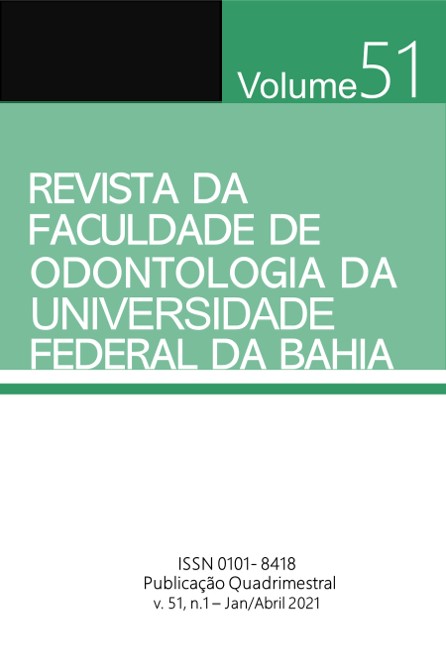RESTAURAÇÃO BIOLÓGICA COMO UMA OPÇÃO POUCO INVASIVA NO TRATAMENTO DE FRATURAS DENTAIS: UMA REVISÃO DE LITERATURA BIOLOGICAL RESTORATION AS A LESS INVASIVE OPTION IN THE TREATMENT OF DENTAL FRACTURES: A LITERATURE REVIEW
DOI:
https://doi.org/10.9771/revfo.v51i1.44223Palavras-chave:
Revisão, Fraturas dos Dentes, Colagem Dentária, Restauração Dentária Permanente, Review, Tooth Fractures, Dental Bonding, Dental Restoration, Permanent.Resumo
A Odontologia Restauradora tem obtido progressos em relação às técnicas para tratamento de traumas dentários, como é o caso da colagem de fragmentos, que se caracteriza como uma técnica fácil, minimamente invasiva, barata e com bons resultados estéticos e funcionais, sendo uma excelente técnica para a aplicação clínica. Objetivo: Realizar uma revisão narrativa da literatura acerca das técnicas de colagem de fragmentos, assim como as suas características, vantagens, desvantagens, limitações, materiais e protocolos clínicos. Resultados: Na técnica de colagem, pode-se utilizar fragmento do próprio paciente (restauração autógena) ou unidades dentárias obtidas a partir de um Biobanco de Dentes Humanos (restauração homógena). Tais técnicas podem ser efetuadas em dentes vitais ou desvitalizados, anteriores ou posteriores, e os resultados dependem do estado do fragmento, a extensão da fratura e os materiais restauradores utilizados para a realização da colagem. Estas técnicas mostram-se viáveis devido à facilidade de ser reproduzida na clínica odontológica e proporcionar ótimo resultado no estabelecimento da estética e da função. Conclusão: O emprego das técnicas de colagens de fragmentos, desde que devidamente realizadas, é uma excelente opção de tratamento para a restauração de dentes fraturados por conta da mínima intervenção, estética favorável, devolução da função, valor acessível, fácil aplicabilidade e ótimos resultados psicológicos.
Restorative dentistry has made progress in relation to techniques for the treatment of dental trauma, as is the case with bonding fragments, which is characterized as an easy, minimally invasive, inexpensive technique with good aesthetic and functional results, being an excellent technique for clinical application. Purpose: Conduct a narrative review of the literature about the techniques of bonding fragments, as well as their characteristics, advantages, disadvantages, limitations, materials and clinical protocols. Results: In the bonding technique, you can use the patient's own fragment (autogenous restoration) or dental units obtained from a Human Teeth Biobank (homogeneous restoration). Such techniques can be performed on vital or devitalized teeth, anterior or posterior, and the results depend on the state of the fragment, the extent of the fracture and the restorative materials used to perform the bonding. These techniques are shown to be viable due to the ease of being reproduced in the dental clinic and providing excellent results in establishing aesthetics and function. Conclusion: The use of fragment bonding techniques, provided they are properly performed, is an excellent treatment option for the restoration of fractured teeth due to minimal intervention, favorable aesthetics, return of function, accessible value, easy applicability and excellent psychological results.
Downloads
Downloads
Publicado
Como Citar
Edição
Seção
Licença
Copyright (c) 2021 Revista da Faculdade de Odontologia da UFBA

Este trabalho está licenciado sob uma licença Creative Commons Attribution-NonCommercial 4.0 International License.

